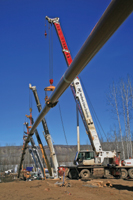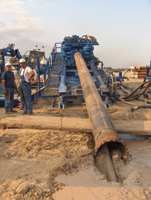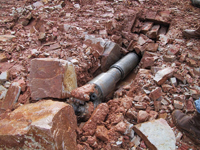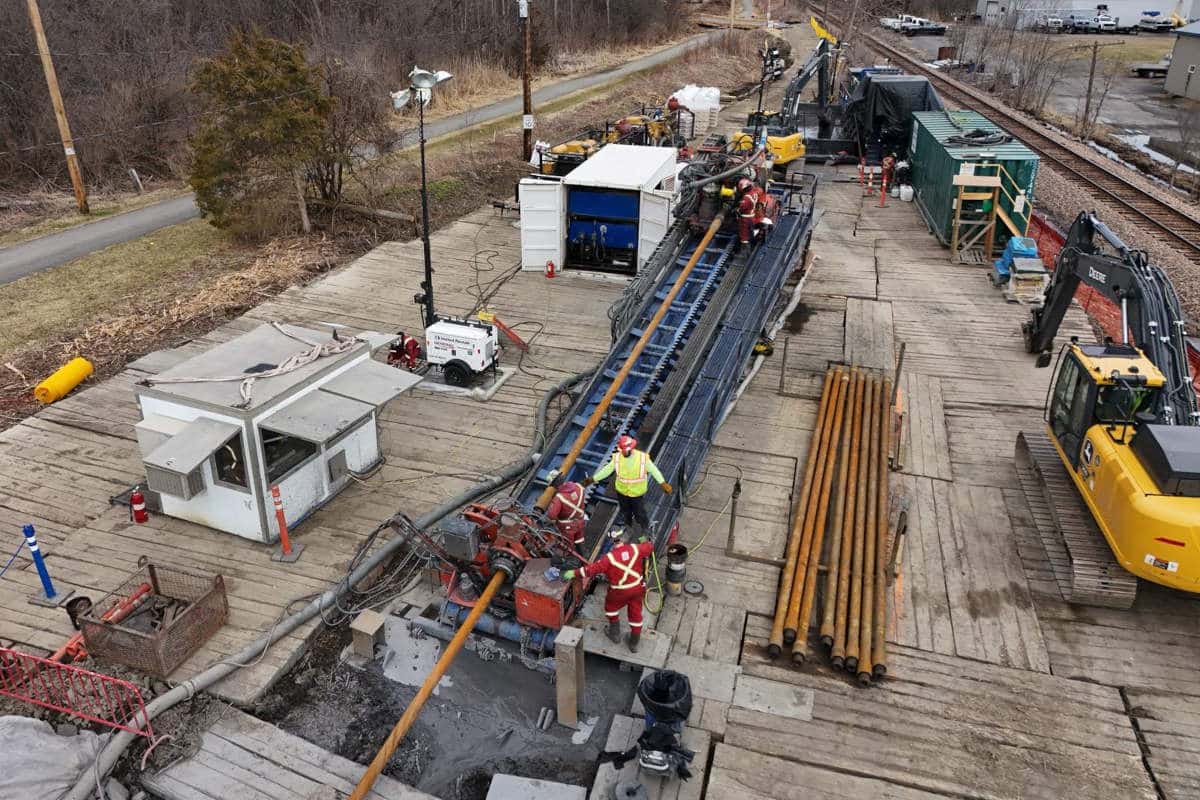2009 HDD Roundtable:
 Each year, Trenchless Technology gauges the horizontal directional drilling (HDD) market by interviewing leading industry experts, manufacturers and contractors for their take on the state of things as they see it. This year, we offer you something a little different. Instead of a long article, we invited a diversity of HDD players to give their perspective on the HDD market, each answering a different topic within the market itself — allowing them to answer in full, in lieu of just snippets of our conversations. The topics for this roundtable included the large and small diameter work, fiber-to-the-home (FTTH) networks, training, qualified operators and manufacturing trends.
Each year, Trenchless Technology gauges the horizontal directional drilling (HDD) market by interviewing leading industry experts, manufacturers and contractors for their take on the state of things as they see it. This year, we offer you something a little different. Instead of a long article, we invited a diversity of HDD players to give their perspective on the HDD market, each answering a different topic within the market itself — allowing them to answer in full, in lieu of just snippets of our conversations. The topics for this roundtable included the large and small diameter work, fiber-to-the-home (FTTH) networks, training, qualified operators and manufacturing trends.
Overall State of HDD Market – 2009
Richard Levings, senior product manager, trenchless products, Ditch Witch
 The horizontal directional drilling market continues to be utilized heavily around the globe. The economy has reduced the back log but contractors continue to say they have two to three months of work rather than six to 12 months of work. The HDD consumables (wear parts and drilling fluid) further validates this as tooling and drill pipe sales remain very strong. Both the Ditch Witch manufacturer and dealer organization are positioned to support end users in helping them be cost-effective and minimize the end-users’ downtime. Our organization is also positioned to provide training to end-users to ensure that the systems are operated and maintained properly.
The horizontal directional drilling market continues to be utilized heavily around the globe. The economy has reduced the back log but contractors continue to say they have two to three months of work rather than six to 12 months of work. The HDD consumables (wear parts and drilling fluid) further validates this as tooling and drill pipe sales remain very strong. Both the Ditch Witch manufacturer and dealer organization are positioned to support end users in helping them be cost-effective and minimize the end-users’ downtime. Our organization is also positioned to provide training to end-users to ensure that the systems are operated and maintained properly.
Even though the economy began to struggle early in 2008, HDD new rig sales remained very strong well into the fourth quarter of 2008. New rig sales have been adversely affected by the economy, which is contributed to consumer confidence and the availability of financing. The new unit sales continue at a reduced rate from previous years. Going forward, it will take longer backlogs of contracts and strong cash positions from the contractors to bolster the new unit sales.
As during the last economic downturn of the early 2000s, new markets will emerge from this as people get “out of the box” and look for more efficient methods of installing utilities and any underground structures. With the focus turning to energy and greener energy sources, some push is being put on the installation of geothermal systems as well as the enhancement of building wind farms worldwide.
The HDD industry has not been exempt from the worldwide economic downturn. 2009 will continue to be challenging for HDD manufacturers and potentially could extend into 2010. We do however expect that HDD utilization will benefit from the worldwide stimulus packages and the consistent demand for utility installation.
HDD Market View
Bob Johnston, vice president and division manager, Henkels & McCoy Inc.
 The horizontal directional drilling market is very interesting. The major players are busy and staying busy. Some upstart companies are trying to get going in the industry. It is difficult because of the schedules that have to be met in today’s market. Sometimes you’re afraid to give a new company a chance because you just can’t take the chance on missing your scheduled deadline. There are some very good horizontal directional drilling companies in the United States and they should be very proud of the good work they have accomplished. With the environmental issues we have today, it makes one wonder where we would be without them.
The horizontal directional drilling market is very interesting. The major players are busy and staying busy. Some upstart companies are trying to get going in the industry. It is difficult because of the schedules that have to be met in today’s market. Sometimes you’re afraid to give a new company a chance because you just can’t take the chance on missing your scheduled deadline. There are some very good horizontal directional drilling companies in the United States and they should be very proud of the good work they have accomplished. With the environmental issues we have today, it makes one wonder where we would be without them.
As the construction season is well under way, most big horizontal directional drill rigs are drilling and will be busy for quite some time. If you need a big rig, you have to plan ahead or lean on your friends in the industry to help out. What are good friends for if you cannot lean on them?
A Small Contractor’s View
Gloria J. Roth, Precision Directional Boring
I am seeing larger projects being designed for the HDD contractor in underground utilities construction, especially the sewer and water market. This has opened additional opportunities to bid as a general contractor. Directional drilling has already proven to be of benefit in confined areas or when there is an environmental issue. Because of this, excavating contractors are realizing the advantage of sub-contacting directional drilling when they have a project/job where excavation is not feasible.
 There appears to be a fair amount of work for the directional drilling contractor. More state and municipal projects are being designed for HDD as engineers become more familiar with directional drilling as an alternate for installing or upgrading existing underground utilities.
There appears to be a fair amount of work for the directional drilling contractor. More state and municipal projects are being designed for HDD as engineers become more familiar with directional drilling as an alternate for installing or upgrading existing underground utilities.
Because of the aging infrastructure and the environmental issues, construction in the sewer and water market seems to be relatively stable and not as negatively affected and impacted by the downturn in the economy as are other areas of the construction industry. With the stimulus money for creating jobs geared toward the infrastructure, sewer/water is probably one of the strongest markets in the underground utility field. We have seen a decline in the telecommunication/power work except for contractors already on board with the owners.
It is important to have employees who understand the sewer and water industry with all of its facets. It has been difficult to find qualified drillers/locators for the sewer and water because of lack of experienced drillers/locators in that field. Most qualified drillers are content to stay with their current employer, which makes it difficult to hire a pre-qualified driller. Most of our current employees were hired in at an entry level position and moved up in the ranks.
The economy and lack of work toward last quarter of 2008 and first quarter of 2009 has affected everyone. It is necessary to work leaner and still produce a good product and keep customers satisfied. The slowdown in construction in general at the end of 2008 and beginning of 2009 has affected all contractors and has resulted in contractors bidding low in order to keep their employees working. This has resulted in lowering the profit margin.
Manufacturer’s Eye on the HDD Market
Ed Savage, trenchless segment manager, Vermeer Corp.
 The general state of the HDD industry is down this year compared to last, which I am sure is not news to many of you. This is evident everywhere from the number of jobs being designed and let to the number of new rigs being put into service.
The general state of the HDD industry is down this year compared to last, which I am sure is not news to many of you. This is evident everywhere from the number of jobs being designed and let to the number of new rigs being put into service.
2009 will be a slow year for HDD manufacturers. Not only has the overall workload slowed compared to last year, but the financial crisis has had an impact on the financing of equipment. Banks have started requiring larger down payments for example, which has limited the number of companies that have been able to obtain financing and upgrade equipment.
The overall market is down more than 50 percent (based off of manufacturer shipments) when compared to this same time last year. While most of this decline has taken place in the smaller size drill rigs, declining energy prices has also caused a significant decrease in the large drill market. Mid-size drill rig sales have not seen as much of a decline.
HDD work in the energy market cycles along with the price of both natural gas and crude. As the prices of natural gas and crude have retracted over the last year, so did the related HDD work. On the positive side, this market does react quickly, so the recent uptick in crude prices should contribute to an increase in drilling activity.
Small fiber work has remained steady both in the rural and urban markets, with more upcoming jobs on the table. Even in a slow economy, consumers continue to demand faster and more reliable Internet/broadband service, which will continue to help drive this market.
As has been a topic of discussion for many years, the global water and sewer infrastructure is currently in a dire state of disrepair. We continue to see HDD utilized in this market, but recently introduced high-accuracy vacuum tunneling equipment may have a larger impact on the small diameter portion of this market. On a positive note, emerging HDD markets that show promise are anything related to alternative or “green” energy, such as wind and geothermal.
HDD EDUCATION & TRAINING
Samuel T. Ariaratnam, Ph.D., P.E., professor, Arizona State University
 In reality, education and training have subtle differences. Education refers to imparting knowledge, while training is the acquisition of skills and competencies as a result of instruction. Training in the HDD industry has been reduced due to financial realities of the current economic situation. Contractors are facing declining revenues and increased competition in this global financial crisis. Today, HDD contractors are being forced to lay off people, not unlike many companies in other employment sectors. Uncertainty among potential project owners, along with a sizeable reduction in available funding, has resulted in many projects being cancelled or placed on hold.
In reality, education and training have subtle differences. Education refers to imparting knowledge, while training is the acquisition of skills and competencies as a result of instruction. Training in the HDD industry has been reduced due to financial realities of the current economic situation. Contractors are facing declining revenues and increased competition in this global financial crisis. Today, HDD contractors are being forced to lay off people, not unlike many companies in other employment sectors. Uncertainty among potential project owners, along with a sizeable reduction in available funding, has resulted in many projects being cancelled or placed on hold.
In 2008, Dr. David Bennett and I delivered five “HDD Good Practices Guidelines” courses through NASTT. A typical training course averages around 25 to 30 attendees; our largest class was 87 attendees in late 2007. This year to date, we have given only two courses, had one cancelled due to low enrollment and do not have any future courses scheduled at this time. In the past, we even provided personalized training to companies that wanted their crews to better engage in good HDD installation practices. The hard reality is that training budgets are the first to get cut regardless of employment sector during an economic downturn.
Unfortunately, 2009 will likely be a slow year for training; however, things are expected to pick up by the second quarter of 2010.
The HDD industry must not sit back in 2009. Education is something that all industry stakeholders should be continually undertaking. There is still an inherent lack of general knowledge regarding the various aspects of HDD. The main target groups are municipal owners, consulting engineers, and college students. I challenge those of you with experience in HDD to offer your services to give a lecture to a civil/construction engineering class at your local university. You would be surprised how often planting these seeds results in future opportunities! Contractors should take this slowdown in work to share their knowledge with local owners and engineers. Lunchtime talks are an excellent vehicle. I personally know a trenchless contractor in my area who is building strong rapport with the local engineering community through the hosting of informative monthly luncheons.
We cannot sit back as an industry with regard to training and education. History tells us that there are cyclical variations in the economy and we need to prepare society for the next wave of opportunity. I truly believe that our industry will rebound and be stronger than ever.
Fiber-to-the-Home & HDD
Joe Savage, president, Fiber-to-the-Home Council
 The recent economic gyrations have not changed one essential truth — that the future of consumer and business telecommunications will be based on technologies that include running fiber-optic cable all the way to the subscriber premises.
The recent economic gyrations have not changed one essential truth — that the future of consumer and business telecommunications will be based on technologies that include running fiber-optic cable all the way to the subscriber premises.
Americans are now using 100 times the bandwidth they used 10 years ago and there are no signs that the ever-increasing demand for faster connections is letting up. Emerging online services that provide videoconferencing, collaborative workspaces and remote data and application storage are driving bandwidth needs ever higher — not only for downloading but for uploading information, as well. Like other business applications, tele-work requires symmetrical bandwidth up and downstream to be effective.
Although North American fiber-to-the-home deployment did not begin in earnest until just a few years ago, there are already nearly 5 million households connected directly into fiber networks — with an annual growth rate above 50 percent. While much of the recent growth has been due to Verizon’s $23 billion investment in FTTH deployment, there are hundreds of smaller telephone companies that are also making the transition to end-to-end fiber in order to boost their service offerings, get the bandwidth they need for decades of growth and win the competition for today’s customers.
Whether it is to ease installation or maintenance (or both), many of these companies view these network upgrades as an opportunity to switch from aerial to underground — something they see as an important element of “future-proofing” their networks. And the desire to minimize surface disruption during deployment, and thereby increase customer satisfaction, has made HDD an important option to consider when they are planning their deployment strategy.
 So, the murky economy notwithstanding, the outlook is pretty clear. America’s bandwidth needs will continue to grow, telecom providers will move to fill that need by putting in fiber in the last mile of their networks, weather and maintenance will drive many deployers to consider burying their cable, and a range of concerns — from ease of installation to maintaining good public and customer relations — will lead many of these to HDD. Indeed, this is why HDD manufacturers and distributors are such an important and valued part of the FTTH industry, particularly as active members of the FTTH Council. Together, we will deliver next-generation bandwidth to satisfy America’s need for speed.
So, the murky economy notwithstanding, the outlook is pretty clear. America’s bandwidth needs will continue to grow, telecom providers will move to fill that need by putting in fiber in the last mile of their networks, weather and maintenance will drive many deployers to consider burying their cable, and a range of concerns — from ease of installation to maintaining good public and customer relations — will lead many of these to HDD. Indeed, this is why HDD manufacturers and distributors are such an important and valued part of the FTTH industry, particularly as active members of the FTTH Council. Together, we will deliver next-generation bandwidth to satisfy America’s need for speed.
Keeping Qualified Drillers
Grady Bell, vice president of business development, Laney Directional Drilling
 What is the state of the HDD industry in the summer of 2009? The temperature outside is sizzling but business as a whole is lukewarm. The major challenge for the last 24 months was to find and keep qualified/experienced personnel to staff the HDD drilling rigs, plus in some areas locating replacement HDD equipment for the HDD operations. Drill pipe and mud systems were especially difficult to obtain in a timely manner.
What is the state of the HDD industry in the summer of 2009? The temperature outside is sizzling but business as a whole is lukewarm. The major challenge for the last 24 months was to find and keep qualified/experienced personnel to staff the HDD drilling rigs, plus in some areas locating replacement HDD equipment for the HDD operations. Drill pipe and mud systems were especially difficult to obtain in a timely manner.
However with the downturn in the national economy, these issues have lessened significantly. Many projects’ start dates have been delayed or postponed and a few have even been cancelled. This situation has created more rig availability for less work to be done. The staffing crunch has eased and now it is not difficult to keep your good people so long as you have a sufficient work load to keep the crew running. Although if you are slow, then your best people still could be lured away with promises of full work weeks and lots of overtime. Having good steady work is the best way to retain your best people.
The difficulty of buying new equipment to replace worn out items and even for expanding your operational fleet has definitely gotten better for the directional drilling contractors. Drill pipe was one of the items that maxi rig operators were having to compete with a booming oilfield market the past few years and the oilfield would pay top dollar for the pipe they needed. This left the HDD contractor with long delivery times and sometimes even less than premium pipe to choose from. The delivery time for mud mixing and mud cleaning systems has now dramatically dropped and in some sizes of equipment you can actually buy units from the manufacturer’s inventory at very competitive prices. It is a supply and demand market.
The large scale HDD market is faring well when compared to the nationwide and even worldwide construction industry. As someone I know put it, “We are just not going to participate in this recession.”
Sharon M. Bueno is managing editor of Trenchless Technology.
![]()




